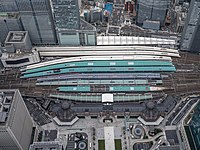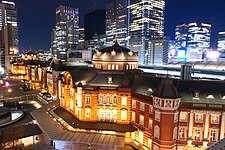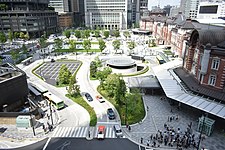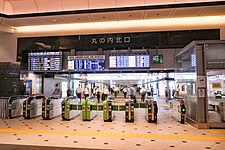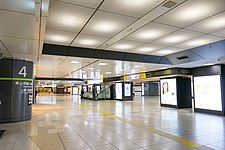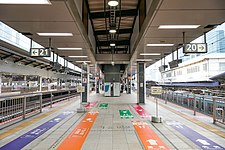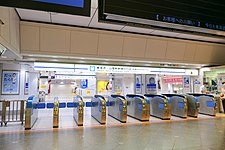railroad.wikisort.org - Station
Tokyo Station (Japanese: 東京駅, Japanese pronunciation: [to̞ːkʲo̞ːe̞kʲi]) is a railway station in Chiyoda, Tokyo, Japan. The original station is located in Chiyoda's Marunouchi business district near the Imperial Palace grounds. The newer Eastern extension is not far from the Ginza commercial district. Due to the large area covered by the station, it is divided into the Marunouchi (west) and Yaesu (east) sides in its directional signage.
Tokyo Station 東京駅 | |
|---|---|
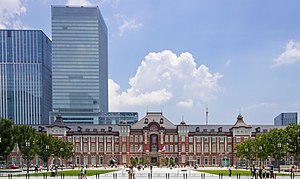 Tokyo Station, Marunouchi side in 2018 | |
| General information | |
| Location | Chiyoda, Tokyo Japan |
| Operated by |
|
| Connections |
|
| History | |
| Opened | 20 December 1914 (JGR) 20 March 1956 (Tokyo Metro) |
| Location | |
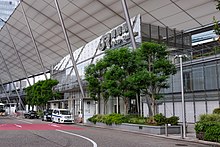

Served by the high-speed rail lines of the Shinkansen network, Tokyo Station is the main inter-city rail terminal in Tokyo. It is the busiest station in Japan, with more than 4,000 trains arriving and departing daily,[1] and the fifth-busiest in Eastern Japan in terms of passenger throughput;[2] on average, more than 500,000 people use Tokyo Station every day.[1] The station is also served by many regional commuter lines of Japan Railways, as well as the Tokyo Metro network.
Lines
Trains on the following lines are available at Tokyo Station:
 JR East
JR East
 Tōhoku Shinkansen
Tōhoku Shinkansen Yamagata Shinkansen
Yamagata Shinkansen Akita Shinkansen
Akita Shinkansen Jōetsu Shinkansen
Jōetsu Shinkansen Hokuriku Shinkansen
Hokuriku Shinkansen Hokkaido Shinkansen
Hokkaido Shinkansen- JT Tōkaidō Main Line
- JU Ueno–Tokyo Line
- JK Keihin–Tōhoku Line
- JY Yamanote Line
- Chūō Main Line (including JC Chūō Line (Rapid))
- Sōbu Main Line (including JO Sōbu Line (Rapid), Limited Express Narita Express, Ayame, Shiosai)
- JO Yokosuka Line (including Limited Express Narita Express)
- JE Keiyō Line
 JR Central
JR Central
 Tōkaidō Shinkansen (through services to/from San'yō Shinkansen operated by JR West)
Tōkaidō Shinkansen (through services to/from San'yō Shinkansen operated by JR West)
 Tokyo Metro
Tokyo Metro
- M Marunouchi Line
The station is linked by underground passageways to the Ōtemachi underground (subway) station complex served by the Tōzai, Chiyoda, Hanzōmon, and Mita subway lines.
It is also possible to walk to the Nijūbashimae, Hibiya, Yūrakuchō, Ginza, and Higashi-ginza Stations completely underground (the last a distance of over 2 km), but these stations can usually be reached more quickly by train.
Tokyo Station is also a major intercity bus terminal, with regular midday service to several cities in the Kantō region and overnight service to the Kansai and Tōhoku regions. The furthest overnight bus service goes to Izumo-taisha, over 800 km away.
Station layout
The main station facade on the western side of the station is brick-built, surviving from the time when the station opened in 1914. The main station consists of 10 island platforms serving 20 tracks, raised above street level running in a north–south direction. The main concourse runs east–west below the platforms.
The Shinkansen lines are on the east (or Yaesu) side of the station, along with a multi-storey Daimaru department store. The entrances nearest to the Shinkansen lines are named Yaesu, and those at the extreme East of the station are named Nihonbashi.
On the far western side is the Marunouchi entrances, which are closest to the two underground Sōbu/Yokosuka line platforms serving four tracks (five stories below ground level). The Narita Express to Narita International Airport (NRT) uses these platforms.
The two Keiyō Line platforms serving four tracks are four stories below ground some hundreds of meters to the south of the main station with moving walkways to serve connecting passengers.
The whole complex is linked by an extensive system of underground passageways that merge with surrounding commercial buildings and shopping centers.
- Tokyo Station
- Tokyo station seen from the sky in 2021
- Tokyo Station night view in 2020
- Tokyo Station Marunouchi Station Square in 2019
- Marunouchi North Exit ticket gate in 2021
- Yaesu South Exit ticket gate in 2021
- Concourse of JR East in 2021
JR
TYOJT01JU01JK26JY01JC01JO19JE01 Tokyo Station 東京駅 | ||||||||||||||||||||||||||||||||||||||||||||||||||||||||||||||||||||||||||||||||||||||||||||||||||||||||||||||||||||||||||||||||||||||||||||||||||||||
|---|---|---|---|---|---|---|---|---|---|---|---|---|---|---|---|---|---|---|---|---|---|---|---|---|---|---|---|---|---|---|---|---|---|---|---|---|---|---|---|---|---|---|---|---|---|---|---|---|---|---|---|---|---|---|---|---|---|---|---|---|---|---|---|---|---|---|---|---|---|---|---|---|---|---|---|---|---|---|---|---|---|---|---|---|---|---|---|---|---|---|---|---|---|---|---|---|---|---|---|---|---|---|---|---|---|---|---|---|---|---|---|---|---|---|---|---|---|---|---|---|---|---|---|---|---|---|---|---|---|---|---|---|---|---|---|---|---|---|---|---|---|---|---|---|---|---|---|---|---|---|
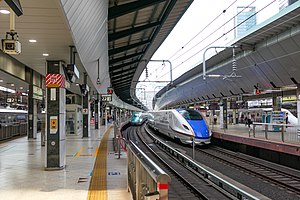 JR East Shinkansen platform in 2021 | ||||||||||||||||||||||||||||||||||||||||||||||||||||||||||||||||||||||||||||||||||||||||||||||||||||||||||||||||||||||||||||||||||||||||||||||||||||||
| General information | ||||||||||||||||||||||||||||||||||||||||||||||||||||||||||||||||||||||||||||||||||||||||||||||||||||||||||||||||||||||||||||||||||||||||||||||||||||||
| Operated by |
| |||||||||||||||||||||||||||||||||||||||||||||||||||||||||||||||||||||||||||||||||||||||||||||||||||||||||||||||||||||||||||||||||||||||||||||||||||||
| Line(s) | Tokaido Shinkansen Tōhoku Shinkansen Tōkaidō Main Line Tōhoku Main Line Chūō Main Line Sōbu Main Line Keiyō Line | |||||||||||||||||||||||||||||||||||||||||||||||||||||||||||||||||||||||||||||||||||||||||||||||||||||||||||||||||||||||||||||||||||||||||||||||||||||
| Connections |
| |||||||||||||||||||||||||||||||||||||||||||||||||||||||||||||||||||||||||||||||||||||||||||||||||||||||||||||||||||||||||||||||||||||||||||||||||||||
| Other information | ||||||||||||||||||||||||||||||||||||||||||||||||||||||||||||||||||||||||||||||||||||||||||||||||||||||||||||||||||||||||||||||||||||||||||||||||||||||
| Station code | JT01 (Tōkaidō Line) JC01 (Chūō Line) JO19 (Yokosuka Line/Sōbu Line (Rapid)) JE01 (Keiyo Line) JY01 (Yamanote Line) JU01 (Utsunomiya Line and Takasaki Line) JK26 (Keihin–Tōhoku Line) | |||||||||||||||||||||||||||||||||||||||||||||||||||||||||||||||||||||||||||||||||||||||||||||||||||||||||||||||||||||||||||||||||||||||||||||||||||||
| History | ||||||||||||||||||||||||||||||||||||||||||||||||||||||||||||||||||||||||||||||||||||||||||||||||||||||||||||||||||||||||||||||||||||||||||||||||||||||
| Opened | 20 December 1914 | |||||||||||||||||||||||||||||||||||||||||||||||||||||||||||||||||||||||||||||||||||||||||||||||||||||||||||||||||||||||||||||||||||||||||||||||||||||
| Services | ||||||||||||||||||||||||||||||||||||||||||||||||||||||||||||||||||||||||||||||||||||||||||||||||||||||||||||||||||||||||||||||||||||||||||||||||||||||
| ||||||||||||||||||||||||||||||||||||||||||||||||||||||||||||||||||||||||||||||||||||||||||||||||||||||||||||||||||||||||||||||||||||||||||||||||||||||
| ||||||||||||||||||||||||||||||||||||||||||||||||||||||||||||||||||||||||||||||||||||||||||||||||||||||||||||||||||||||||||||||||||||||||||||||||||||||
Main-level platforms
(listed in order from west to east)
JR East
| 1–2 | JC Chūō Line | for Shinjuku, Tachikawa, Hachiōji, Takao, Ōtsuki JC Ōme Line for Haijima, Ōme and Oku-Tama via Tachikawa JC Itsukaichi Line for Musashi-Itsukaichi via Tachikawa and Haijima ■ Hachikō Line for Komagawa via Tachikawa and Haijima (morning/night service) ■ Fujikyuko Line for Kawaguchiko via Ōtsuki □ Ltd. Express Azusa[Note 1] for Matsumoto □ Ltd. Express Kaiji[Note 2] for Kōfu and Ryūō |
| 3 | JK Keihin–Tōhoku Line | for Ueno, Nippori, Akabane, and Ōmiya |
| 4 | JY Yamanote Line | for Ueno, Nippori, and Ikebukuro |
| 5 | JY Yamanote Line | for Shinagawa and Shibuya |
| 6 | JK Keihin–Tōhoku Line | for Shinagawa, Kawasaki, Yokohama, and Ōfuna |
| 7–8 | JU Ueno–Tokyo Line | for Ueno, Ōmiya, Utsunomiya, and Kuroiso (via JU Utsunomiya Line) |
| for Ueno, Ōmiya, Takasaki, and Maebashi (via JU Takasaki Line) | ||
| for Ueno, Nippori, Toride, and Mito □ Ltd. Express Hitachi/Tokiwa for Iwaki (via JJ Jōban Line) | ||
| JT Tōkaidō Line | for Yokohama, Fujisawa, Atami, Numazu JT Itō Line for Itō via Atami | |
| 9–10 | JT Tōkaidō Line | for Yokohama, Fujisawa, Atami, Numazu JT Itō Line for Itō via Atami □ Ltd. Express Odoriko & Saphir Odoriko for Izukyū Shimoda and Shuzenji □ Sleeper Ltd. Express Sunrise Izumo for Okayama and Izumoshi □ Sleeper Ltd. Express Sunrise Seto for Okayama and Takamatsu |
| 20–23 | ■ Tōhoku Shinkansen | for Fukushima, Sendai, Morioka, Shin-Aomori and Shin-Hakodate-Hokuto (via Hokkaido Shinkansen) |
| ■ Yamagata Shinkansen | for Fukushima, Yamagata, and Shinjo | |
| ■ Akita Shinkansen | for Sendai, Morioka and Akita | |
| ■ Jōetsu Shinkansen | for Takasaki and Echigo-Yuzawa and Niigata | |
| ■ Hokuriku Shinkansen | for Takasaki, Nagano, Toyama, and Kanazawa |
- Azusa No. 25 starts service here towards Matsumoto.
- Kaiji No. 113, 115, 121, 123 starts service here towards Kōfu, and Kaiji No. 117, 119 starts service here towards Ryūō.
Yokosuka/Sōbu Line platforms
| Sōbu 1–2 | JO Yokosuka Line | for Yokohama, Ōfuna, Kamakura, Zushi and Kurihama □ Ltd. Express Narita Express for Yokohama and Shinjuku (via JS Shōnan-Shinjuku Line) |
| Sōbu 2 | ■ Sōbu Main Line | □ Ltd. Express Shiosai for Narutō and Chōshi |
| Sōbu 2–4 | JO Sōbu Line (Rapid) | for Kinshichō, Funabashi, Chiba and Narita Airport (Terminal 2·3 and Terminal 1) |
| Sōbu 4 | ■ Sōbu Main Line | □ Ltd. Express Narita Express for Narita Airport |
Keiyo Line platforms
| Keiyo 1 | JE Keiyo Line | for Shin-Kiba, Maihama, Kaihimmakuhari, Soga □ Ltd. Express Sazanami for Kimitsu (via Uchibō Line) □ Ltd. Express Wakashio for Awa-Kamogawa (via Sotobo Line) |
| JM Musashino Line through service | for Nishi-Funabashi and Fuchūhommachi | |
| Keiyo 2–4 | JE Keiyo Line | for Shin-Kiba, Maihama, Kaihimmakuhari and Soga |
| JM Musashino Line through service | for Nishi-Funabashi and Fuchūhommachi |
- JR East Tokyo Station
- Chūō Main Line platform in 2021
- Yamanote and Keihin-Tōhoku Line platform in 2021
- Tōkaidō Main Line platform in 2021
- Tōhoku Shinkansen platform in 2021
- Yokosuka and Sōbu Main Line platform in 2021
- Keiyō Line platform in 2021
JR Central
| 14–19 | ■ Tokaido Shinkansen | for Nagoya, Shin-Osaka and Hakata (via Sanyō Shinkansen) |
Originally, platforms 3 to 10 were numbered as platforms 1 to 8 and additional platforms were numbered sequentially from west to east through the opening of the Tōkaidō Shinkansen in 1964. Platforms 9 to 13 were used for the Tōkaidō Main Line and Yokosuka Line but were removed in 1988, and platforms 12 and 13 were then used for the new Tōhoku Shinkansen from 1991 to 1997. The current Chūō Main Line platform opened in 1995 as platforms 1 and 2, and other platforms were renumbered accordingly, leaving platforms 10 and 11 unused. The current platform numbering became effective in 1997 when one of the Tōkaidō Main Line platforms was repurposed for the Jōetsu Shinkansen as platforms 20 and 21. The existing Tōhoku Shinkansen platforms were simultaneously renumbered as 22 and 23.
- JR Central Tokyo Station
- Yaesu North Exit ticket gate in 2021
- Nihombashi Exit ticket gate in 2021
- JR East Shinkansen transfer ticket gate in 2021
- JR East Conventional line transfer ticket gate in 2021
- Tōkaidō Shinkansen platform in 2021
- Departure information board in 2021
Tokyo Metro
M17 Tokyo Station 東京駅 | |||||||||||
|---|---|---|---|---|---|---|---|---|---|---|---|
| Tokyo Metro station | |||||||||||
 Marunouchi Line platform in 2022 | |||||||||||
| General information | |||||||||||
| Operated by | |||||||||||
| Line(s) | |||||||||||
| Connections |
| ||||||||||
| Other information | |||||||||||
| Station code | M-17 | ||||||||||
| History | |||||||||||
| Opened | 20 March 1956 | ||||||||||
| Services | |||||||||||
| |||||||||||
| 1 | M Tokyo Metro Marunouchi Line | for Ginza, Shinjuku and Ogikubo |
| 2 | M Tokyo Metro Marunouchi Line | for Otemachi and Ikebukuro |
- Marunouchi Line ticket gate in 2022
History

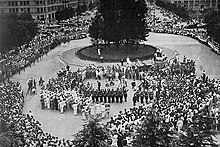


In 1889, a Tokyo municipal committee drew up plans for an elevated railway line connecting the Tōkaidō Main Line terminal at Shinbashi to the Nippon Railway (now Tōhoku Main Line) terminal at Ueno. The Imperial Diet resolved in 1896 to construct a new station on this line called Central Station (中央停車場, Chūō Teishajō), located directly in front of the gardens of the Imperial Palace.[1]
Construction was delayed by the outbreak of the First Sino-Japanese War and Russo-Japanese War, but finally commenced in 1908. The three-story station building was designed by architect Tatsuno Kingo (who also designed Manseibashi Station and the nearby Bank of Japan building) as a restrained celebration of Japan's costly victory in the Russo-Japanese War. The building is often rumored to be fashioned after Amsterdam Centraal station in the Netherlands, although there is little evidence to support the opinion. Terunobu Fujimori, a scholar of Western architecture, denies the rumor, having studied Tatsuno's styles as well as the building itself.[3]
Tokyo Station opened on December 20, 1914 with four platforms;[1] two serving electric trains (current Yamanote/Keihin–Tōhoku Line platforms) and two serving non-electric trains (current Tōkaidō Line platforms). The Chūō Main Line extension to the station was completed in 1919 and originally stopped at the platform now used by northbound Yamanote/Keihin–Tōhoku trains. During this early era, the station only had gates on the Marunouchi side, with the north side serving as an exit and the south side serving as an entrance.[4] The Yaesu side of the station opened in 1929.
Much of the station was destroyed in a B-29 firebombing raid on May 25, 1945. The bombing shattered the impressive rooftop domes and the entire third floor of the building. The station was quickly rebuilt within a year, but the restored building had only two stories instead of three, and simple angular roofs were built in place of the original domes.[1] These postwar alterations were blamed for creating the mistaken impression that the building was based on the Centraal station in Amsterdam. Plans in the 1980s to demolish the building and replace it with a larger structure were derailed by a preservation movement.[5]
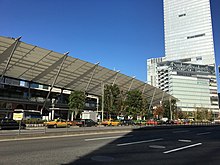
The Yaesu side was also rebuilt after the war, but the new structure was damaged by fire in 1949, and this side of the building was then significantly upgraded with a contemporary exterior and a large Daimaru department store. The new Yaesu side facilities opened in 1953, including two new platforms for Tōkaidō Main Line services (now used by Shinkansen trains). Two more platforms opened in 1964 to accommodate the first Shinkansen services. The Yaesu side was partially rebuilt again in 1991 to accommodate the Shinkansen extension from Ueno.
A plan was finalized in 1971 to build a Narita Shinkansen high-speed line connecting Tokyo Station to Narita International Airport. The line was envisioned as extending underground from Tokyo to Shinjuku Station, and the plan was to build the platforms underneath Kajibashi-dori (to the south of Tokyo Station) to avoid the need to run the line under the Imperial Palace. Construction of the Narita Shinkansen was halted in 1983 due to difficulties acquiring the necessary land to build the line, but the area set aside for its platforms was eventually used for the Keiyō Line and Musashino Line terminals, which opened in 1990.[6]
From July 1987, the station hosted a series of regular free public concerts referred to as "Tokyo Eki Kon" (Tokyo Station Concerts). These were first held as a celebration of the launch of Japan Railways Group as the privatized successor to the state-owned Japanese National Railways. Altogether 246 concerts were performed, but the event was discontinued when its popularity waned and the last concert took place in November 2000. The event returned in 2004 as the "Aka Renga (Red Brick) Concerts" but it was again suspended, after 19 concerts, when redevelopment of the station started in earnest. In 2012, as the reconstruction was nearing completion, there were calls for the concerts to resume.[7]
The station facilities of the Marunouchi Line were inherited by Tokyo Metro after the privatization of the Teito Rapid Transit Authority (TRTA) in 2004.[8]
The Tokyo Station complex has undergone extensive development, including major improvements to the Marunouchi (west) and Yaesu (east) sides of the station. The Marunouchi side underwent an extensive five-year renovation, completed in October 2012, in which the historic 98-year-old façade on this side of the station was restored to its pre-war condition. The restoration work included recreating the two domes according to their original design.[9] The surrounding area was converted into a broad plaza (Marunouchi Central Plaza) extending into a walkway toward the Imperial Palace, with space for bus and taxi ranks. In contrast, the Yaesu side of the station is very urban in appearance. The North and South GranTokyo towers are connected to the terminal by the GranRoof, a new commercial facility with a large canopy representing a "sail of light" which covers the outdoor areas. The high-rise towers include multi-story shopping areas and the offices of a number of leading companies and universities.[1] This part of the project was completed in 2013.
Assassinations
Tokyo Station has been the site of the assassination of two Japanese prime ministers. On November 4, 1921, Hara Takashi was stabbed to death by a right-wing railroad switchman in front of the south wing as he arrived to board a train for Kyoto. On November 14, 1930, Osachi Hamaguchi was shot by a member of the Aikokusha ultra-nationalist secret society. He survived the attack but died of his wounds in August the following year.[5]
- The spot where Hamaguchi was shot
- Plaque commemorating the Hamaguchi shooting
Proposed developments
There was a proposal to build a spur to Tokyo Station from the nearby Toei Asakusa Line, which would provide another connection to the subway network, and also possibly provide faster connections from the station to Tokyo's airports, Haneda and Narita.[10] The plan has yet to be formally adopted. Authorities are re-considering a similar plan as part of the infrastructure improvements for the 2020 Summer Olympics; the proposed line would cut travel time to Haneda from 30 minutes to 18 minutes, and to Narita from 55 minutes to 36 minutes, at a total cost of around 400 billion yen.[11]
There are also plans to extend the Tsukuba Express from Akihabara to Tokyo. In September 2013, a number of municipalities along the Tsukuba Express line in Ibaraki Prefecture submitted a proposal to complete the extension at the same time as the new airport-to-airport line.[12]
Passenger statistics
In fiscal 2018, the JR East station was used by an average of 467,165 passengers daily (boarding passengers only), making it the third busiest station on the JR East network.[13] Over the same fiscal year, the Tokyo Metro station was used by an average of 218,275 passengers daily (both exiting and entering passengers), making it the ninth-busiest Tokyo Metro station.[14] The passenger figures (boarding passengers only) for the JR East (formerly JNR) station in previous years are as shown below.
| Fiscal year | Annual total |
|---|---|
| 1914 | 553,105[15] |
| 1919 | 4,879,042[16] |
| 1924 | 15,953,910[17] |
| 1929 | 24,926,502[18] |
| 1934 | 24,119,757[19] |
| Fiscal year | Daily average |
|---|---|
| 1960 | 331,275[20] |
| 1971 | 352,109[20] |
| 1984 | 338,203[20] |
| 2000 | 372,611[21] |
| 2005 | 379,350[22] |
| 2010 | 381,704[23] |
| 2011 | 380,997[24] |
| 2012 | 402,277[25] |
| 2013 | 415,908[26] |
| 2014 | 417,822[27] |
| 2015 | 434,633[28] |
| 2016 | 439,554[29] |
| 2017 | 452,549[30] |
| 2018 | 467,165[13] |
Surrounding area
Districts
- Marunouchi
- Yaesu
- Ginza
Buildings
- Tokyo Imperial Palace
- Marunouchi Building
- Shin-Marunouchi Building
- JP Tower
- Tokyo International Forum
- Mitsubishi Ichigokan Museum, Tokyo
Hotels
- Shangri-La Hotel, Tokyo
- Metropolitan Hotel, Tokyo
Stations
Other stations within walking distance of Tokyo station include the following.
- Ōtemachi Station (Tokyo Metro Marunouchi Line, Tokyo Metro Chiyoda Line, Tokyo Metro Tōzai Line, Tokyo Metro Hanzōmon Line, Toei Mita Line)
- Hatchōbori Station (Keiyō Line, Tokyo Metro Hibiya Line)
- Nihombashi Station (Tokyo Metro Ginza Line, Tokyo Metro Tōzai Line, Toei Asakusa Line)
- Mitsukoshimae Station (Tokyo Metro Hanzōmon Line, Tokyo Metro Ginza Line)
- Shin-Nihombashi Station (Sōbu Line Rapid)
- Nijūbashimae Station (
 Tokyo Metro Chiyoda Line)
Tokyo Metro Chiyoda Line) - Hibiya Station (Tokyo Metro Hibiya Line, Tokyo Metro Chiyoda Line, Toei Mita Line)
- Yūrakuchō Station (Yamanote Line, Keihin-Tōhoku Line, Tokyo Metro Yūrakuchō Line)
- Ginza-itchōme Station (Tokyo Metro Yūrakuchō Line)
- Kyōbashi Station (Tokyo Metro Ginza Line)
- Takarachō Station (Toei Asakusa Line)
Bus terminal
This section does not cite any sources. (January 2016) |
- Yaesu South Exit Highway Bus Terminal
| Nickname | Destination | Major stops | Operation |
|---|---|---|---|
| La Foret | Aomori Station | Direct | JR Bus Tōhoku |
| Tsugaru | Aomori Station | Aomori Kenko Land | Kōnan Bus Company |
| Sirius | Shichinohe-Towada Station | Hachinohe Station, Towadashi Station | Kokusai Kogyo
Towada Kankō Electric Railway |
| Dream Akita/Yokohama | Akita University | Akita Station | JR Bus Tohoku |
| Dream Chokai | Ugo-Honjō Station | Kisakata Station, Konoura Station, Nikaho Station | JR Bus Tohoku
Ugo Kotsu |
| Dream Morioka"Rakuchin" | Morioka Bus Center | Morioka Station | JR Bus Tohoku
Kokusai Kogyo Iwateken Kotsu |
| Dream Sasanishiki | Furukawa Station | Sendai Station, Izumi-Chūō Station, Taiwa | JR Bus Tohoku |
| Dream Fukushima/Yokohama | Fukushima Station | Kōriyama Station | JR Bus Tohoku |
| Yume Kaidou Aizu | Aizu-Wakamatsu Station | Inawashiro Station | JR Bus Kanto |
| Iwaki | Iwaki Station | Kitaibaraki, Nakoso, Yumoto, Iwaki Chuo | JR Busu Kanto
Tobu Bus Central Shin Joban Kotsu |
| Tokyo Yumeguri | Kusatsu Onsen | Direct | JR Bus Kanto |
| Marronnier Tokyo | Sano Shintoshi Bus Terminal | Sano Premium Outret | JR Bus Kanto |
| Hitachi | Takahagi Station | Hitachi-Taga Station, Hitachi Station | JR Bus Kanto
Hitachi Dentetsu |
| Hitachi-Ota Line | Hitachi-Ōta | Naka IC, Naka City Office, Nukata-Minamigou | JR BUs Kanto
Ibaraki Kotsu |
| Hitachi-Daigo Line | Hitachi-Daigo | Naka IC, Hitachiōmiya, Fukuroda Falls | Ibaraki Kotsu |
| Katsuta/Tokai | Japan Atomic Energy Agency | Hitachinaka, Katsuta Station, Tōkai Station | Ibaraki Kotsu |
| Mito | Mito Station | Ishioka, Akatsuka Station, Ibaraki University | JR Bus Kanto
Ibaraki Kotsu Kantō Railway |
| Ibaraki Airport Line | Ibaraki Airport | Direct | Kanto Railway |
| Tsukuba | University of Tsukuba | Namiki 2, Namiki 1, Tsukuba Center | JR Bus Kanto
Kanto Railway |
| Joso Route | Iwai | Shin-Moriya Station, Mitsukaidō Station | Kanto Railway
Kantetsu Purple Bus |
| Kashima | Kashima Shrine | Suigo-Itako, Kashimajingū Station, Kashima Soccer Stadium | JR Bus Kanto
Keisei Bus Kanto Railway |
| Hasaki | Hasaki | Suigo-Itako, Kamisu | JR Bus Kanto
Kanto Railway |
| The Access Narita | Narita International Airport | Direct | JR Bus Kanto
Heiwa Kotsu Aska Kotsu |
| Yokaichiba Route | Sōsa City Office | Tomisato, Tako, Yōkaichiba Station | JR Bus Kanto
Chiba Kotsu |
| Boso Nanohana | Tateyama Station | Kazusa-Minato, Chikura, Awa-Shirahama | JR Bus Kanto
Nitto Kotsu |
| Yoshikawa Matsubushi Line | Matsubushi | Misato, Yoshikawa Station | JR Bus Kanto |
| Skytree Shuttle | Tokyo Skytree | Edo-Tokyo Museum, Tobu Hotel Levant Tokyo | JR Bus Kanto
Tobu Bus Central |
| Midnight Arrow Kasukabe | Kasukabe Station | Sōka, Shin-Koshigaya, Koshigaya, Sengendai | Tobu Bus Central |
| Midnight Express | Kabe Station | Haijima, Kumagawa, Fussa, Hamura, Ozaku | Nishi Tokyo Bus |
| Midnight Express | Takao Station | Nishi-Hachiōji Station | Nishi Tokyo Bus |
| Midnight Arrow | Ōfuna Station | Yokohama Station, Higashi-Totsuka Station | Kanagawa Chuo kotsu |
| Midnight Arrow | Hiratsuka Station | Totsuka Station, Kōnandai Station, Fujisawa Station | Kanagawa Chuo kotsu |
| Midnight Arrow | Hon-Atsugi Station | Machida Station, Sagami-Ōno Station, Ebina Station | Kanagawa Chuo kotsu |
| Tokyo Hakone Line | Hakone-Tōgendai | Gotemba Station, Sengokuhara | JR Bus Kanto
Odakyu Hakone Kosoku Bus |
| Tokyo Kawaguchiko Line | Kawaguchiko Station | Gotemba Station, Lake Yamanaka, Fuji-Q Highland | JR Bus Kanto
Fujikyu Yamanashi Bus |
| Willer Express | Nagano Station | Nagano, Nagano-Ojimada | Willer Express Hokushinetsu |
| Hakuba Snow Magic | Hakuba Cortina | Hakuba Goryu, Hakuba Happo | Alpico Kōtsū |
| Sansan Numazu Tokyo | Numazu Garrage | Numazu Station | Fujikyu City Bus |
| Kaguyahime Express | Takaoka Garrage | Shin-Fuji Station, Fuji Station | Fujikyu Shizuoka Bus |
| Yakisoba Express | Fujinomiya Garrage | Fujinomiya City Office, Fujinomiya Station | Fujikyu Shizuoka Bus |
| Shimizu Liner | Miho no Matsubara | Shimizu Station, Shin-Shimizu Station | JR Bus Kanto
Shizutetsu Justline |
| Tomei Highway Bus | Nagoya Station | Shizuoka Station, Hamamatsu Station | JR Bus Kanto
JR Bus Tech JR Tokai Bus |
| Dream Shizuoka/Hamamatsu | Hamamatsu Station | Shizuoka Station, Kakegawa Station | JR Tokai Bus |
| Chita Seagull | Chita Handa Station | Chiryū Station, Kariya Station | JR Bus Kanto |
| Dream Nagoya | Nagoya Station | Nisshin Station, Chikusa, Sakae Station, Gifu Station | JR Bus Kanto
JR Tokai Bus |
| Dream Kanazawa | Kanazawa Institute of Technology | Toyama Station, Kanazawa Station | JR Bus Kanto
West JR Bus |
| Dream Fukui | Fukui Station | Tsuruga, Takefu, Sabae | JR Bus Kanto
Keifuku Bus Fukui Railway |
| Dream / Hirutokkyu | Ōsaka Station | Kyōto Station, Sannomiya Station, Nara Station | JR Bus Kanto
West JR Bus |
| Dream Nanba/Sakai | Sakaishi Station | Kyōtanabe, Osaka City Air Terminal, Namba Station | Nankai Bus |
| Dream Tokushima | Anan Station | Naruto, Matsushige, Tokushima Station, Komatsushima | JR Bus Kanto
JR Shikoku Bus |
| Dream Takamatsu | Kannonji Station | Takamatsu Station, Sakaide | |
| Dream Kochi | Harimayabashi Station | Kōchi Station | |
| Dream Matsuyama | Matsuyama Station | Mishima-Kawanoe, Kawauchi, Matsuyama IC, Okaido | |
| Keihin Kibi Dream | Kurashiki Station | Sanyo IC, Okayama Station | Chugoku JR Bus |
| New Breeze | Hiroshima Bus Center | Hiroshima Station, Kure Station | Chugoku JR Bus
Odakyu City Bus |
| Dream Okayama/Hiroshima | Hiroshima Bus Center | Okayama Station, Hiroshima Station | Chugoku JR Bus |
| Tokubetsu Bin | Ube-Shinkawa Station | Hiroshima, Shin-Yamaguchi | Chugoku JR Bus |
| Susanoo | Izumo-taisha | Tamatsukuri, Shinji, Hishikawa IC, Izumoshi Station | Ichibata Bus
Chugoku JR Bus |
| Hagi Express | Hagi Bus Center | Iwakuni Station, Tokuyama Station, Hōfu | Bocho Kotsu |
Sister stations
Tokyo Station has "sister station" agreements with Amsterdam Centraal station in the Netherlands, Grand Central Terminal in New York, USA, Beijing railway station in China, Hsinchu Station in Taiwan,[31] and Frankfurt (Main) Hauptbahnhof in Germany.[32]
See also
- List of East Japan Railway Company stations
- List of railway stations in Japan
- Transport in Greater Tokyo
- List of development projects in Tokyo
- Ramen Street – an area in Tokyo Station's underground mall specializing in ramen dishes
References
- Ito, Masami (December 13, 2014). "Tokyo Station at 100: all change". The Japan Times. Retrieved May 22, 2020.
- 各駅の乗車人員 (in Japanese). East Japan Railway Company.
- Kenchiku Tantei Uten Kekkō (建築探偵 雨天決行; "Architecture Detective, Rain or Shine"), Terunobu Fujimori, ISBN 978-4-02-261179-6
- Nakata, Hiroko (October 23, 2012). "Tokyo Station's Marunouchi side restored to 1914 glory". The Japan Times. Archived from the original on October 27, 2012.
- Watanabe, Hiroshi (2001). The architecture of Tokyo. Axel Menges, Stuttgart/London. pp. 83–84. ISBN 3-930698-93-5.
- "東京駅の京葉線、なぜ遠い?近道は有楽町 成田新幹線構想を再利用". 日本経済新聞. February 4, 2014. Retrieved February 4, 2014.
- Ushijima, Kota "Fans want encore of 'dreamy' Tokyo Station concerts". The Daily Yomiuri. October 1, 2012. Retrieved on October 2, 2012
- "「営団地下鉄」から「東京メトロ」へ" [From "Teito Rapid Transit Authority" to "Tokyo Metro"]. Tokyo Metro Online. July 8, 2006. Archived from the original on May 16, 2012. Retrieved May 29, 2022.
- "Marunouchi Station Building Highlights". tokyostationcity.com. Retrieved May 23, 2020.
- 都営浅草線東京駅接着等の事業化推進に関する検討 調査結果のとりまとめ Archived 2007-08-24 at the Wayback Machine, May 2003.
- "羽田・成田発着を拡大、五輪へインフラ整備急ぐ" [Race to increase slots at Haneda & Narita and build infrastructure for Olympics]. Nihon Keizai Shimbun. Nikkei Inc. September 10, 2013. Retrieved September 10, 2013.
- "TX東京駅延伸で茨城の沿線自治体市議会が意見書". 日本経済新聞. September 21, 2013. Retrieved September 24, 2013.
- 各駅の乗車人員 (2018年度) [Station passenger boarding figures (Fiscal 2018)] (in Japanese). Japan: East Japan Railway Company. Retrieved March 17, 2020.
- 各駅の乗降人員ランキング [Station usage ranking] (in Japanese). Tokyo Metro. Retrieved August 31, 2014.
- 東京府 編 (1916). 東京府統計書. 大正3年 [Tōkyō-Fu Statistics Book (1914)] (in Japanese). Vol. 1. 東京府. p. 756. (National Diet Library Digital Archive) (digital page number 386)
- 東京府 編 (1922). 東京府統計書. 大正8年 [Tōkyō-Fu Statistics Book (1919)] (in Japanese). Vol. 2. 東京府. p. 241. (National Diet Library Digital Archive) (digital page number 265)
- 東京府 編 (1927). 東京府統計書. 大正13年 [Tōkyō-Fu Statistics Book (1924)] (in Japanese). Vol. 1. 東京府. p. 504. (National Diet Library Digital Archive) (digital page number 292)
- 東京府 編 (1931). 東京府統計書. 昭和4年 [Tōkyō-Fu Statistics Book (1929)] (in Japanese). Vol. 1. 東京府. p. 564. (National Diet Library Digital Archive) (digital page number 334)
- 東京府 編 (1936). 東京府統計書. 昭和9年 [Tōkyō-Fu Statistics Book (1934)] (in Japanese). Vol. 1. 東京府. p. 565. (National Diet Library Digital Archive) (digital page number 341)
- 日本国有鉄道停車場一覧 [JNR Station Directory]. Japan: Japanese National Railways. 1985. p. 480. ISBN 4-533-00503-9.
- 各駅の乗車人員 (2000年度) [Station passenger figures (Fiscal 2000)] (in Japanese). Japan: East Japan Railway Company. Retrieved July 2, 2013.
- 各駅の乗車人員 (2005年度) [Station passenger figures (Fiscal 2005)] (in Japanese). Japan: East Japan Railway Company. Retrieved July 2, 2013.
- 各駅の乗車人員 (2010年度) [Station passenger figures (Fiscal 2010)] (in Japanese). Japan: East Japan Railway Company. Retrieved July 2, 2013.
- 各駅の乗車人員 (2011年度) [Station passenger figures (Fiscal 2011)] (in Japanese). Japan: East Japan Railway Company. Retrieved July 2, 2013.
- 各駅の乗車人員 (2012年度) [Station passenger figures (Fiscal 2012)] (in Japanese). Japan: East Japan Railway Company. Retrieved August 31, 2014.
- 各駅の乗車人員 (2013年度) [Station passenger boarding figures (Fiscal 2013)] (in Japanese). Japan: East Japan Railway Company. Retrieved August 31, 2014.
- 各駅の乗車人員 (2014年度) [Station passenger boarding figures (Fiscal 2014)] (in Japanese). Japan: East Japan Railway Company. Retrieved March 17, 2020.
- 各駅の乗車人員 (2015年度) [Station passenger boarding figures (Fiscal 2015)] (in Japanese). Japan: East Japan Railway Company. Retrieved March 17, 2020.
- 各駅の乗車人員 (2016年度) [Station passenger boarding figures (Fiscal 2016)] (in Japanese). Japan: East Japan Railway Company. Retrieved March 17, 2020.
- 各駅の乗車人員 (2017年度) [Station passenger boarding figures (Fiscal 2017)] (in Japanese). Japan: East Japan Railway Company. Retrieved March 17, 2020.
- "Tokyo Station to get a sister station in Taiwan". The Japan Times. Japan. Kyodo. February 10, 2015. Retrieved February 12, 2015.
- "Tokyo and Frankfurt Central become sister stations". The Asahi Shimbun Asia & Japan Watch. The Asahi Shimbun Company. September 26, 2015. Archived from the original on September 27, 2015. Retrieved September 29, 2015.
External links
- JR East map of Tokyo Station
- Tokyo Station (JR East) (in Japanese)
- Tokyo Station (JR Central) (in Japanese)
- Tokyo Station (Tokyo Metro) (in Japanese)
- Guide Of Tokyo Train Station
На других языках
[de] Bahnhof Tokio
Der Bahnhof Tokio (jap. 東京駅, Tōkyō-eki) ist ein Bahnhof in der japanischen Hauptstadt Tokio. Er liegt an der Grenze zwischen den zentralen Bezirken Chiyoda und Chūō bzw. zwischen den Stadtteilen Marunouchi im Westen und Yaesu im Osten. In der Nähe befinden sich der Kaiserpalast, zahlreiche Wolkenkratzer und das Ginza-Viertel. Als nomineller Hauptbahnhof Tokios gehört er zu den wichtigsten Bahnhöfen des Landes, die Bahnhöfe Shinjuku und Ikebukuro zählen allerdings mehr Reisende.- [en] Tokyo Station
[ru] Токио (станция)
Станция Токио (яп. 東京駅 То:кё: эки) — железнодорожный вокзал, расположенный в бизнес-квартале Маруноути района Тиёда, недалеко от Гиндзы и Императорского Дворца.Другой контент может иметь иную лицензию. Перед использованием материалов сайта WikiSort.org внимательно изучите правила лицензирования конкретных элементов наполнения сайта.
WikiSort.org - проект по пересортировке и дополнению контента Википедии



